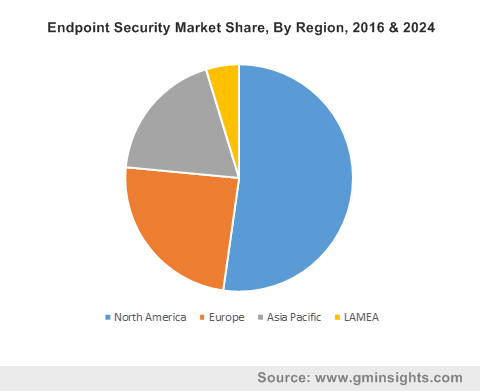A brief overview of the global endpoint security market with a competitive frame of reference, tech advancements to drive industry progression over 2017-2024
Publisher : Fractovia | Published Date : April 2018Request Sample
Regarded as one of the fastest emerging niche verticals of sustainable and smart technologies industry, endpoint security market has been garnering humongous limelight in the recent times. Apparently, the growing popularity of this business space can undoubtedly be attributed to the increasing number of cyberattacks and malwares across the globe. As organizations struggle to deploy the appropriate expertise to investigate potential threats and maintain their detection tools, the increasing complexity of these attacks further paint a grim picture of today’s network security scenario. The maturation of endpoint security industry can also be accredited to the stringent regulatory guidelines being prescribed by numerous governments world over to safeguard critical data and information.
Endpoint Security Market Size, By Application, 2016 & 2024 (USD Million)

Moreover, the emergence of sophisticated ransomwares, which has practically plagued every business vertical, is one of the most significant factors driving endpoint security industry share. In fact, as per reliable estimates, the remuneration portfolio of the overall endpoint security market stood at USD 4 billion in the year 2016 which demonstrates the sturdy growth that is being observed in this business sphere.
Below is a synopsis of the contributions being made by prominent firms toward endpoint security industry space:
Symantec: The leading cyber security solutions provider is rightly touted as one of the most influential names in the global endpoint security market space having made a remarkable contribution to this sphere for over a decade now. The US based giant has recently unveiled a fully featured and its most advanced endpoint solution with an aim to bring together Endpoint Detection and Response (EDR), Mobile Threat Defense, intensive protection through advanced machine learning, and deception technology.
Moreover, the latest solution is being described as the first of its kind across the endpoint security industry, as it delivers these features in a single form, lowers the overall costs, meets the challenges of the cloud generation by simplifying and improving security, and optimizes the environment of endpoint architecture. Concurrently, it would be prudent to mention that the new solution has been built on the firm’s Symantec Endpoint Protection (SEP) platform which is known to effectively tackle malwares and ransomwares.
Cisco: In order to reinforce its stance in the global endpoint security market, the American multinational technology behemoth has recently launched a series of augmentations to its Advanced Malware Protection (AMP) for Endpoints platform. Apparently, the latest enhancements provide revamped email security and visibility capabilities to enable network security professionals to gather accurate insights for investigating data breaches. Moreover, the new email security features supplement the advanced phishing and domain protection services along with malware detection and prevention systems.
With the unveiling of new domain protection services, Cisco further plans to assist organizations across diverse business verticals to set up Domain-based Message Authentication, Reporting, and Conformance (DMARC) email authentication capability.
McAfee: With an aim to identify new cybersecurity product requirements in the endpoint security market, McAfee has recently introduced two state-of-the-art physical and cyber security operations centers in Texas and Ireland. The facilities, named as McAfee Fusion Centers, would be available to consumers who wish to witness human-machine learning in practice and to educate themselves on how to better manage their own security operations.
The California based company has also announced a new security operations architecture which would enhance McAfee Advanced Threat Defense and McAfee Investigator. It would be prudent to mention that the entire solution has been installed in the latest fusion centers. Apparently, the efforts being deployed by McAfee to strengthen its position in endpoint security industry would prove to be of immense help in laying out a robust blueprint for successfully implementing complex security operations in real time.
Moreover, other leading industry participants such as Microsoft, Kaspersky, Panda Security, IBM, Bitdefender, Comodo, and Trend Micro are continually expanding and upgrading their product portfolio through R&D programs to match up with the fluctuating dynamics of cyber-crimes. It is quite apparent from the aforementioned instances that the chief endpoint security market players have been making concerted efforts to innovate efficient and highly advanced products which would assist the revenue share of this business space to proliferate substantially over the ensuing years.